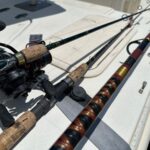You’ve probably heard someone use the words ‘oar‘ and ‘paddle‘ interchangeably.
Although oars and paddles serve the same purpose, to steer vessels through the water, they differ in their materials, design, and intended uses.
Read on below for our in-depth comparison of oars vs paddles and the best uses for each.
Table of Contents
What’s the Difference Between Oars vs Paddles?
Although oars and paddles, technically speaking, are both blades that are used to propel a vessel by hand through the water… there are several key differences between the two.
The most notable difference between them is that oars are used for rowing and paddles are solely used for paddling.
A good pneumonic that helps me to remember this distinction is:
- Remember the “P” in Paddles – Paddles are always used for Paddling
- Remember “R” in Oar – Oars are always used for Rowing
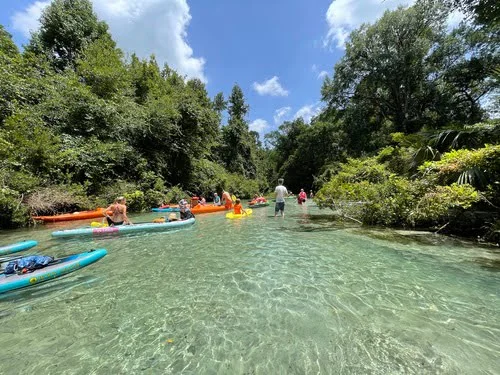
Oars are exclusively single-bladed. They are often heavy and constructed from hardwood materials. They are designed with a flat blade on one end and the other end is held by the rower.
Oars are typically used in pairs, and are affixed to the port or starboard of the boat or vessel by an oarlock. This is so they cannot come loose from the boat.
One oar blade is required on each side to move a vessel in a straight line. An oarsman will transfer energy from their body to the oar handle, and then to the blade, to move the boat through the water.
Paddles are designed to be hand-held and free from the boat. They come in both single and double-bladed variations and are typically crafted from strong, but light materials like fiberglass and aluminum.
Since they are not connected to the vessel, like oars, a canoer or kayaker’s hands will act as the pivot point for applying energy to the paddle and creating motion through the water.
The type of propulsion offered by paddles also differs from that of oars. Oars push water away, creating backward momentum that propels the vessel in the opposite direction that the paddler faces.
Paddles pull water towards the vessel, using forward momentum, moving the vessel in the same direction the paddler faces. Therefore, paddlers actually move forward while rowers travel backward.
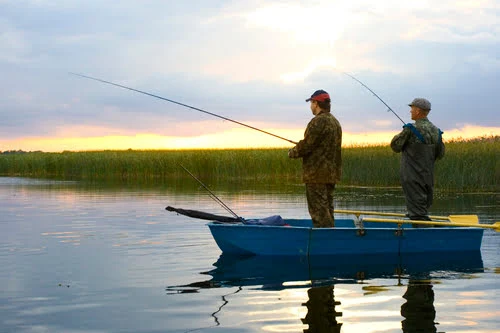
Oars
Selecting the right oar(s) for your particular vessel and rowing style will definitely elevate your rowing experience.
It is crucial to select the correct length oars that give you the right leverage ratio as this is essential for optimal rowing experience.
Let’s dive deeper into the different types and styles of oars and paddles. Below are some common vessels that use oars:
- Rowboats
- Skiffs
- Dories
- Dinghies
- Yacht Tenders
- Sweep Boats
- Skulling Boats
Once you’ve pinpointed the right length oars for your boat, the next thing is to choose the correct blade style.
Choosing the right blade type for you is a subjective matter and might be influenced by several factors including the oar length, boat hull design, and of course, personal preference.
Oars come in two different blade types: flat blades and spoon blades.
Flat Blade Oars
Generally ¼-inch thick at the blade end, flat blade oars are designed with a bulbous rib that runs from the throat of the shaft down to the blade.
This is to offer the right stiffness, strength, and elegant transition from the shaft down to the blade.
Depending on where you’ll be rowing, you can choose between spruce flat blade oars and ash flat blade oars.
Spruce flat-blade oars are lighter and a lot easier to use but are quite rare.

On the other hand, you can go for ash flat blade oars, which are very hard to use because they’re heavier but ideal if you anticipate encountering rocks during your rowing escapades
This style is common in coastal saltwater locations, such as the New England coastline.
Spoon Blade Oars
Spoon blade oars are ideal for boats designed for fixed-seat rowing, such as skiffs, but can also be ideal for dories and whaleboats.
They’re generally finished, top-quality spar varnished, and have epoxy tops that are reinforced with glass strands.
Spoon blade oars are about 20 percent more effective than flat blade oars, but only if the hull of the boat is configured with fine entries and rounded bottoms.
Spoon blade oars are ideal for canoes (with oarlocks), and various types of rowboats, that can be used for fishing such as dinghies.
Sculling Oars
Perfect for a sliding seat rowing system, sculling oars are usually longer than normal oars used in fixed seat rowing.
These oars can use either the Macon blade shape or the Hatchet blade shape.
They generally measure 9’ 6” in length and are constructed to be as light as possible.
Macon blade shape tends to be proportioned on both sides, while Hatchets are irregular and are slightly more efficient than Macon blades.
Related: Pond Fishing Boats…Which Style is Best For You?
Paddles
Whether you’re paddling on tropical South Beach or a river in Texas, the paddles that you choose can make all the difference. Paddles come in a variety of shapes, sizes, and types.

Below are vessels that commonly use paddles:
- Single Person Kayaks
- Tandem Kayaks
- Canoes
- Stand-Up Paddle Boards
- Rafts
The main paddles to consider include single-blade paddles, double-blade paddles, and yes, even triple-blade paddles.
Before going into the different types of paddles, you should know the right size paddle for you. This means that you should know your height and the size of your boat.
If you’re short, you’ll go for a shorter paddle. And if you’re tall, you should choose a longer paddle.
However, a typical paddle blade should be around 18 inches long and 8 inches wide, while the overall paddle should be about 4-6 feet in length.
Single-Blade Paddles
Single-blade paddles have a blade on one side and a t-shaped handle on the other.
They’re generally used to move a vessel by two paddlers who should paddle in unison. These paddles are ideal for partner trips and especially if you want to synchronize movement while paddling a canoe or a stand-up paddleboard.
They’re unique and very easy to use compared to other paddle types. Single-blade paddles are the perfect choice for canoes.
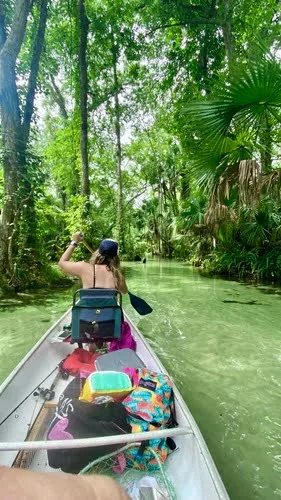
Double-Blade Paddles
The most common type of paddles, double-blade paddles, have blades on both sides of the paddle and can be used on either side, by either a single or double paddler.
They’re designed with feather blades that allow the paddler to pull the blade through the water and increase efficiency.
Double-blade paddles are specifically meant to be used on kayaks. They should be kept small and lightweight to optimize performance and reduce strain.
See Also: Canoe or kayak for fishing…which is better?
Frequently Asked Questions
Do Canoes Use Paddles or Oars?
Canoes use paddles, not oars nearly 99% of the time. While it is possible to fit a canoe with oarlocks and use oars, it is not common and requires special hardware and a different style of rowing.
Can You Use Oars On A Kayak?
Kayaks are designed to be used with paddles, not oars. Oars require oarlocks and the ability to ‘row’ in a large range of motion is not typical on most kayaks.
Is Rowing Faster Than Kayaking?
The speed of rowing depends on the size and type of vessel and the skills of the rower.
Rowing can be very fast, and efficient but only if it’s on a lightweight boat. Kayaking can also be quick, but speed is determined by the skills of the paddler.
What Is The Easiest Boat To Paddle?
The easiest boat to paddle is a simple one-person kayak. This does not require any special skills, other than basic coordination.
Simply choose a single or double-sided paddle to gently propel the kayak through the water.
Is A Stand-Up Paddle Board Hard?
Stand-up paddleboards are moderately difficult to learn. The proper technique does require the use of core muscle and balance, especially in windy or choppy conditions.
That being said, almost anyone can learn to stand up paddleboard and it’s a great way to exercise and spend time outdoors.
If you haven’t guessed yet, I love fishing and everything about it!
To learn more about why I started Panfish Nation, visit the About page and follow along on Social Media:


Download a copy of my FREE Lure Color Selection Chart & Knot Guide!
Stay up to date with fishing reports, tackle reviews, industry news, and much more! We respect your privacy, unsubscribe at any time.
Additional Reading
- Crazy Facts About the World Record Crappie

- What Size Hooks for Smallmouth Bass? Quick Guide

- Large and in Charge-Mouth: 10 of the Best Bass Lures of All Time (And Where to Buy Them)

- Emperor of the Sun(fish): What You Need to Know About the World Record Bluegill
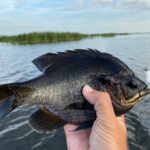
- The Seven Best Lures for Fall Bass Fishing
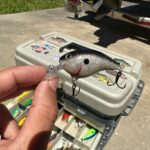
- Which Fishing Line is Best for Bass Fishing With A Spinning Reel?
